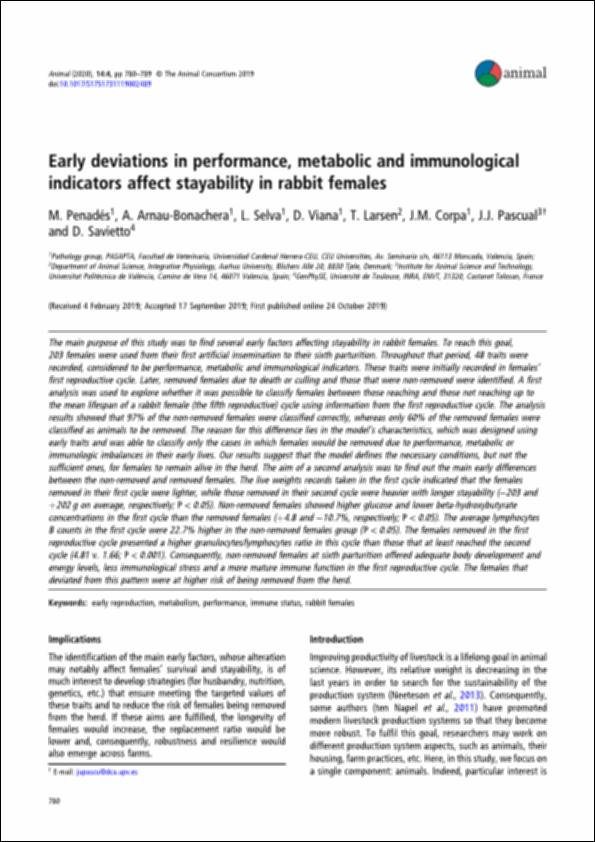Please use this identifier to cite or link to this item:
http://hdl.handle.net/10637/12457Early deviations in performance, metabolic and immunological indicators affect stayability in rabbit females
| Title: | Early deviations in performance, metabolic and immunological indicators affect stayability in rabbit females |
| Authors : | Penadés Fons, Mariola Arnau Bonachera, Alberto Selva Martínez, Laura Viana Martín, David Larsen, Torben Corpa Arenas, Juan Manuel |
| Keywords: | Conejos - Metabolismo.; Rabbits - Metabolism.; Rabbits - Reproduction.; Conejos - Inmunología.; Conejos - Reproducción.; Rabbits - Immunology. |
| Publisher: | Elsevier. |
| Citation: | Penadés, M., Arnau-Bonachera, A., Selva, L., Viana, D., Larsen, T., Corpa, J.M., et al. (2020). Early deviations in performance, metabolic and immunological indicators affect stayability in rabbit females. Animal, vol. 14, i. 4 (abr.), pp. 780-789. DOI: https://doi.org/10.1017/S1751731119002489 |
| Abstract: | The main purpose of this study was to find several early factors affecting stayability in rabbit females. To reach this goal, 203 females were used from their first artificial insemination to their sixth parturition. Throughout that period, 48 traits were recorded, considered to be performance, metabolic and immunological indicators. These traits were initially recorded in females’ first reproductive cycle. Later, removed females due to death or culling and those that were non-removed were identified. A first analysis was used to explore whether it was possible to classify females between those reaching and those not reaching up to the mean lifespan of a rabbit female (the fifth reproductive) cycle using information from the first reproductive cycle. The analysis results showed that 97% of the non-removed females were classified correctly, whereas only 60% of the removed females were classified as animals to be removed. The reason for this difference lies in the model’s characteristics, which was designed using early traits and was able to classify only the cases in which females would be removed due to performance, metabolic or immunologic imbalances in their early lives. Our results suggest that the model defines the necessary conditions, but not the sufficient ones, for females to remain alive in the herd. The aim of a second analysis was to find out the main early differences between the non-removed and removed females. The live weights records taken in the first cycle indicated that the females removed in their first cycle were lighter, while those removed in their second cycle were heavier with longer stayability (−203 and þ202 g on average, respectively; P < 0.05). Non-removed females showed higher glucose and lower beta-hydroxybutyrate concentrations in the first cycle than the removed females (þ4.8 and −10.7%, respectively; P < 0.05). The average lymphocytes B counts in the first cycle were 22.7% higher in the non-removed females group (P < 0.05). The females removed in the first reproductive cycle presented a higher granulocytes/lymphocytes ratio in this cycle than those that at least reached the second cycle (4.81 v. 1.66; P < 0.001). Consequently, non-removed females at sixth parturition offered adequate body development and energy levels, less immunological stress and a more mature immune function in the first reproductive cycle. The females that deviated from this pattern were at higher risk of being removed from the herd. |
| Description: | Este artículo se encuentra disponible en la siguiente URL: https://www.sciencedirect.com/science/article/pii/S1751731119002489?via%3Dihub En esta investigación también participan: A. Arnau-Bonachera, L. Selva, D. Viana, T. Larsen, J.M. Corpa, J.J. Pascual y D. Savietto. |
| URI: | http://hdl.handle.net/10637/12457 |
| Rights : | http://creativecommons.org/licenses/by-nc-nd/4.0/deed.es |
| ISSN: | 1751-7311 1751-732X (Electrónico). |
| Issue Date: | 21-Apr-2020 |
| Center : | Universidad Cardenal Herrera-CEU |
| Appears in Collections: | Dpto. Producción y Sanidad Animal, Salud Pública Veterinaria y Ciencia y Tecnología de los Alimentos |
Items in DSpace are protected by copyright, with all rights reserved, unless otherwise indicated.


